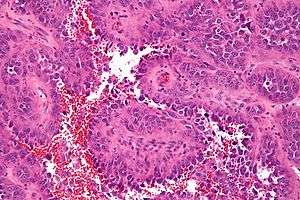Angiosarcoma
| Angiosarcoma | |
|---|---|
|
Micrograph of an angiosarcoma. H&E stain. | |
| Classification and external resources | |
| ICD-O | M9120/3 |
| eMedicine | med/138 |
| MeSH | D006394 |
Angiosarcoma is a cancer of the cells that line the walls of blood vessels or lymphatic vessels. The lining of the vessel walls is called the endothelium. Cancers from the walls of blood vessels are called hemangiosarcomas and cancers from the walls of lymphatic vessels are called lymphangiosarcomas.
Because the cancers are carried by the blood flow or lymphatic flow, they can more easily metastisize to distant sites, particularly the liver and lungs. Most tumors of visceral blood and lymphatic vessel walls are cancerous (malignant). Hemangiosarcomas and lymphangiosarcomas of the skin are not common. Kaposi's sarcoma is a different type of cancer that also involves endothelial-type cells. Angiosarcomas will show signs of hemorrhage and necrosis. Pathologically, tumor cells will show increased nuclear to cytoplasm ratio, nuclear hyperchromasia, nuclear pleomorphism and high mitotic activity will be observed.[1]
Angiosarcoma of the liver, a rare fatal tumor, has been seen in workers intensively exposed to the gas vinyl chloride monomer (VCM) for prolonged periods while working in polyvinyl chloride (PVC) polymerization plants. It has also been associated with individuals exposed to arsenic-containing insecticides and Thorotrast. In dogs, hemangiosarcoma is relatively common, especially in larger breeds such as golden retrievers and Labrador retrievers.
See also
References
External links
- Angiosarcoma by James Lewis, MD and Vernon Sondak, MD, FACS
- Angiosarcoma Awareness; current angiosarcoma research
